|
|
Advertisement:
|
|
GIGABYTE G1.Assassin Motherboard |
|
Join the community - in the OCAU Forums!
|
Motherboard Features
Motherboard Features:
GIGABYTE has implemented a variety of technologies with the G1.Assassin. The core features and components include:
Ultra Durable 3 technology includes a 2oz copper design for a lower working temperature and a reduction of hotspots, better overclocking, better power efficiency allowing electric current to flow with less resistance and enabling more power efficient circuits with lower power loss and less heat generated. You will find the majority of GIGABYTE motherboards sporting at least the 'Classic' version, whereas high-end models like this will up the ante even more by including Japanese solid capacitors, Driver MOSFETs and Ferrite Core Chokes alongside improved power circuitry from top to bottom.
 
SATA 3.0 6Gb/s functionality is provided by Marvell's 88SE9182 controller that supports RAID 0 and RAID 1 configurations. The SATA 3.0 ports are highlighted in white, and are linked by a PCI-E x2 link to the X58 Northbridge, while the other four SATA 2.0 ports are finished in black, and run natively off the ICH10R Southbridge chipset allowing for RAID 0, RAID 1, RAID 5, and RAID 10 as traditionally found with Intel X58 based motherboards.
 
16 Power Phase Design provides more CPU power and allows for greater overclocking margins when pushing your system to the limit. This combined with GIGABYTE's Dual-Power technology and multi-gear power saving that is adjustable via Windows, allows the CPU's VRM power phases to split evenly into 2 sets of power engines that operate in tandem. This allows 1 set of power phases to rest while the other is active, as opposed to a traditional power design, where all the power phases are always active. GIGABYTE's Auto Dual Power Switching ensures that each set of phases share the power workload, effectively doubling the lifespan of the phases.
 
Creative SoundBlaster X-Fi has been integrated onto the motherboard PCB, replacing the usual onboard Realtek audio that would lack the extra features of this solution, and most importantly reduces the need for extra add-on cards that not only add to the final PC build cost, but also may interfere with PCI-Express video cards. The SoundBlaster Digital Audio Processor (20K2) not only takes care of the usual set of 3.5mm jacks, it also outputs via the coaxial and optical connections at the rear of the motherboard, as well as the front case audio connector located on the bottom of the motherboard that also features high capacity amplification, which is able to drive 150 ? loads that some premium headphones require.
 
Bigfoot Networks Killer E2100 network processor replaces the traditional Realtek network solution found in the majority of motherboard implementations. Underneath the Killer E2100 sticker we have a Freescale Semiconductor MPC8308 PowerQUICC II Pro Processor running at 400MHz along with two Samsung DDR2 SDRAM of 512MB just below it, and to the right is a Spansion flash chip to take care of any future bios updates. The use of such a dedicated network processor allows a multitude of advanced network features to be adjusted and tweaked via the windows software to make sure gamers have the best online gaming experience possible. Consider the E2100 a professional hardware solution to a consumer level problem, and as such combined with the software provided allows for automatic game detection, visual bandwidth control, PC hardware monitoring, application management including blocking and prioritisation, not to mention a dedicated network processor rather than a software solution.
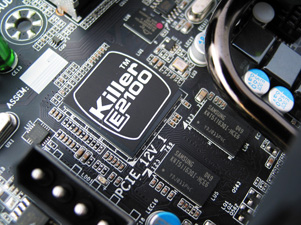 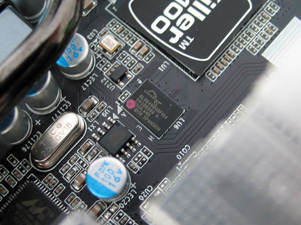
4-Way CrossfireX and SLI support is one of the key features that differentiate the G1.Assassin from other models in the GIGABYTE G1 range. The only way to fit a fourth PCI-E x16 slot was to move to a XL-ATX form factor. This allows each PCI-E x16 slot to be spaced evenly and also permits the inclusion of two PCI-E x2 slots and one legacy PCI slot between each full sized PCI-E slot in case you need it. The Northbridge heatsink is low enough to not interfere with even the longest of cards, the same goes for the right-angled SATA ports.
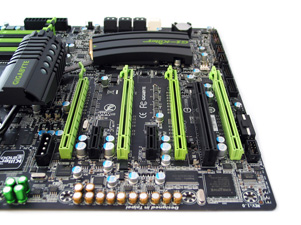 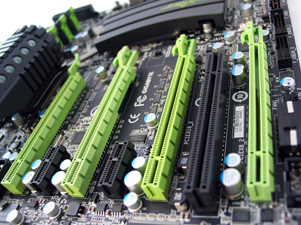
USB 3.0 Support continues to be provided by a third party NEC D720200F1 controller, due to no Intel chipset offering a native USB 3.0 solution. The G1.Assassin utilises a single NEC chip solution linked with two VIA VLI VL810-Q8 hubs that offer four USB 3.0 connections from each hub. This allows the G1.Assassin to sport four USB 3.0 ports on the rear I/O panel, and another four via the two USB 3.0 front panel headers on the motherboard, with one being able to be utilised by the GIGABYTE provided font panel, and the other for cases that support USB 3.0 headers.
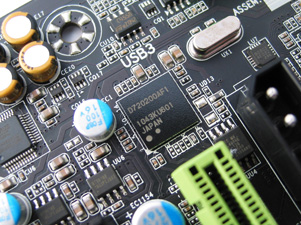 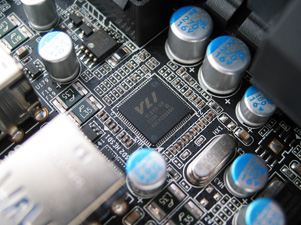
ON/OFF Charge Technology provides a set of white and red coloured USB pin headers that can easily be connected to your system's front USB 2.0 ports allowing extra amperage for your iPhone, iPod Touch, iPad to charge correctly. Unlike traditional designs GIGABYTE's ON/OFF technology will allow your devices to keep charging even while your PC is off or in a variety of standby modes.
In addition, a 5.25" bay front access panel is included in the package featuring two extra USB 3.0 ports, a combo e-SATA and USB connector as well as a Quick Boost button for enabling custom BIOS set profiles with the push of a button. This button is illuminated and changes colour once pressed. All these can be connected to the headers on the bottom of the motherboard.
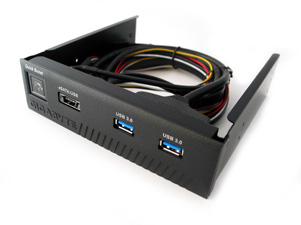 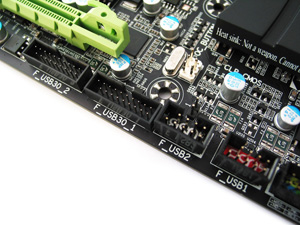
DualBIOS - This now familiar feature includes a second BIOS chip on the motherboard. If something goes wrong during a BIOS flash, the system will automatically revert to a previous version stored on the backup BIOS chip without hesitation. Not far below that we have the illuminated Debug LED panel; especially helpful during boot and system diagnostics. GIGABYTE has also been able to include 3TB+ hard drive support without the need to move to a full UEFI BIOS.
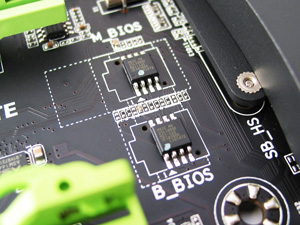 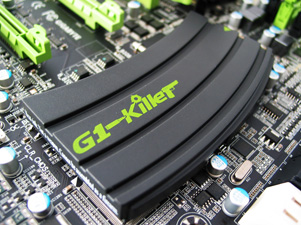
Dual 8-pin power connectors are included as any enthusiast motherboards should. Adding this second connector makes sure the CPU and its power circuitry are never starved for power, and with the inclusion of 4-way GPU support GIGABYTE's engineers have also included two 4-pin Molex connections, one on the top of the first PCI-Express x16 slot and one below the last providing a even more stable motherboard once all the slots are filled up.
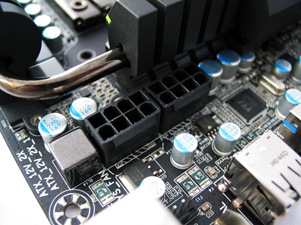 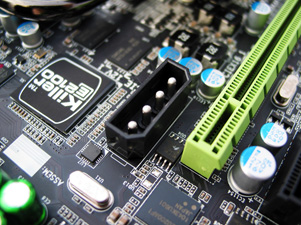
Power Phase LED display is an extension of GIGABYTE's Dynamic Energy Saver package that runs via Windows. The LED display gives you a visual indication of the load/usage of the power circuitry and can be easily disabled via the software if the LED lightshow isn't for you. If you choose not to utilise DES, then you'll only notice the lights show up during booting before they deactivate, before entering Windows.
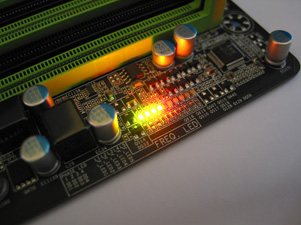 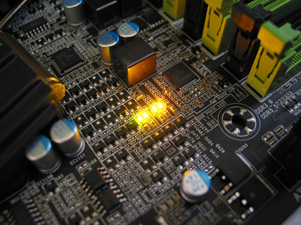
LED illumination is present in a few key areas on the motherboard, most notably on the Northbridge heatsink with an array of five bright green LEDs, while at the base of the heatsink you can find LEDs for the Northbridge voltage. To the left of the heatsink near the Killer NIC is a green LED for the LAN device. In addition, the board has LEDs for the CPU voltage, CPU temperature, DDR phases and voltage, Northbridge phases and Southbridge voltage and overclock frequency levels.
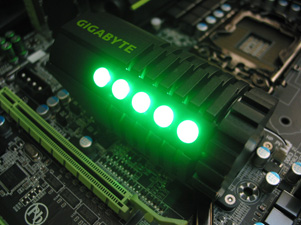 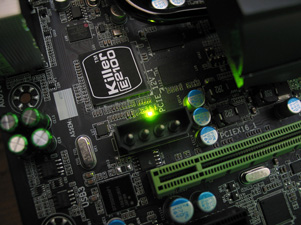
Not all of these LEDs are active all the time, but during overclocking they can be especially helpful, allowing you to keep an eye on critical areas as well as help diagnostics.
|
|
Advertisement:
All original content copyright James Rolfe.
All rights reserved. No reproduction allowed without written permission.
Interested in advertising on OCAU? Contact us for info.
|

|


